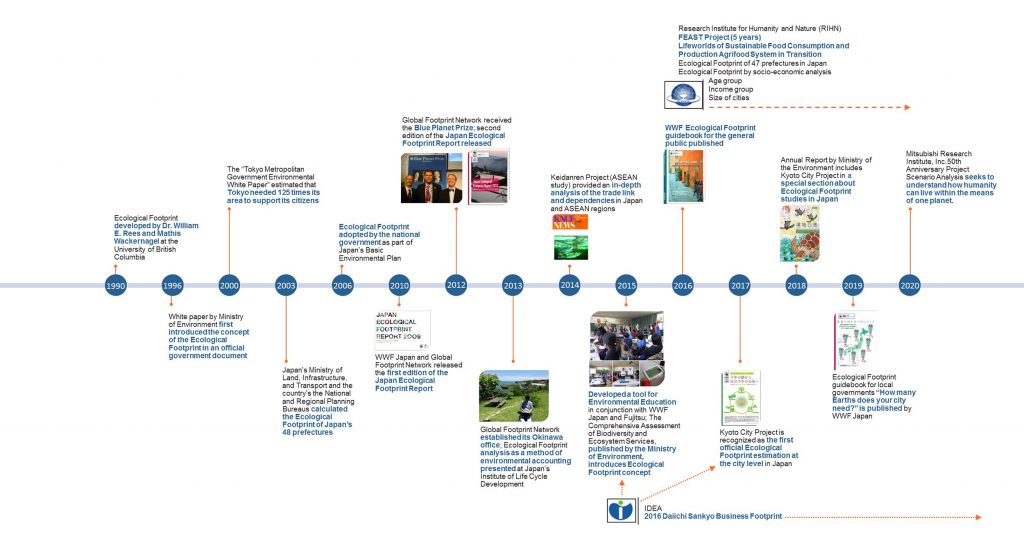Updated April 2023
In 1996, Japan was the first country to officially adopt the Ecological Footprint. Now, Global Footprint Network works with Ecological Footprint Japan to serve Japan’s cities, businesses, regional governments, national ministries, research organizations, and NGOs.
Jump to:
Government Engagement Public Awareness Business Footprinting
History of the Ecological Footprint in Japan
Japan, home to the world’s most populous metropolitan area (Tokyo) and the third largest economy in the world, has historically been very resource conscious due to its limited biocapacity. The Ecological Footprint was first mentioned in an official Japanese government document in 1996, seven years before Global Footprint Network was founded. The early foothold in Japan was facilitated by Yoshihiko Wada, Ph.D., a professor of economics at Doshisha University. Prof. Wada collaborated with Dr. Mathis Wackernagel on Footprint research in its early years and also received his PhD under Professor William E. Rees.
In 2012, Mathis Wackernagel and Bill Rees jointly received Japan’s prestigious environmental prize: the Blue Planet Prize.
click image to view full size
Government Engagement
The Japanese Ministry of the Environment’s 2018 Annual Report featured the Ecological Footprint results for Japan and highlighted Global Footprint Network’s Kyoto city project, completed in collaboration with IDEA Consultants and WWF Japan (pages 68-70). The report noted that if everyone in the world lived like residents in Kyoto, we would need two Earths. This metric would drop to 1.4 Earths if Kyoto achieves its goal of reducing greenhouse gas emissions 40% in 2030 from 1990 levels.
The country’s Ministry of the Environment first included the Ecological Footprint in its 1996 Annual White Paper, which was the first major step by the national government to take action on sustainability. Since then, the Footprint has been a key indicator in several of Japan’s sustainability campaigns. Highlights (in chronological order) include:
- The major metropolitan area of Tokyo released the “Tokyo Metropolitan Government Environmental White Paper” in 2000 and estimated that Tokyo needed 125 times its area to support its citizens. This report marked the first time a city in Japan used Ecological Footprint accounting to calculate its natural resource consumption and make strides to change its trajectory towards one planet living.
- Japan’s Ministry of Land, Infrastructure, and Transport and National and Regional Planning Bureaus calculated the Ecological Footprint of Japan’s 47 prefectures in a 2003 joint report. This effort marked the first time the Footprint was used at a subnational level to help regional agencies understand their resource constraints.
- The Ecological Footprint was adopted by the national government as part of Japan’s Basic Environmental Plan in 2006 and featured strategies for pursuing a more sustainable society and policies for developing diverse energy sources.
- Global Footprint Network supported IDEA Consultants Inc. in the report released by the Ministry of Environment in 2016. The report, the Comprehensive Assessment of Biodiversity and Ecosystem Services (JBO2: Japan Biodiversity Outlook 2), acknowledged the Ecological Footprint in analyzing ecosystem services and human well-being.
- Kyoto City became the first local government in Japan to calculate its own Footprint in 2016 as part of a joint project involving IDEA Consultants, WWF Japan, and Global Footprint Network. Results in the report showed that the carbon Footprint accounts for 64 percent of the total Ecological Footprint and that if everyone lived like the average Kyoto resident, we would need two planets. The report also set an ambitious goal for Kyoto to reduce carbon emissions 40 percent by 2030 in order to reduce its Ecological Footprint.
- Japan’s Cabinet officially recognized the Ecological Footprint as a key indicator with its adoption of the country’s National Biodiversity Strategy 2023-2030. The Footprint is included as an indicator in two of the Strategy’s five goals: achieving a nature-positive economy (target strategy 3-2) and increasing individuals’ understanding of biodiversity’s value (target strategy 4-2).
Public awareness
To amplify the efforts of the Japanese government to use the Ecological Footprint in policymaking, Global Footprint Network teamed up with organizations such as WWF Japan to help raise sustainability awareness through several campaigns.
- In 2023, The Asahi Shimbun, one of Japan’s largest newspapers, published a story called “8 billion people are straining our Earth to the breaking point”. It is based on Global Footprint Network data. The Japanese version of the story includes a graph showing how humanity’s Ecological Footprint has changed over time.
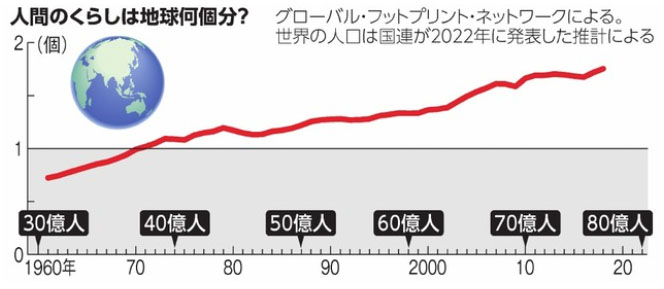
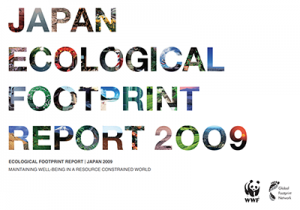 The 2010 Ecological Footprint Report found Japan’s Ecological Footprint exceeded the world average by a whopping 50 percent. The report included policy recommendations for decision-makers and tips for consumers to help change consumption patterns and reduce carbon emissions.
The 2010 Ecological Footprint Report found Japan’s Ecological Footprint exceeded the world average by a whopping 50 percent. The report included policy recommendations for decision-makers and tips for consumers to help change consumption patterns and reduce carbon emissions.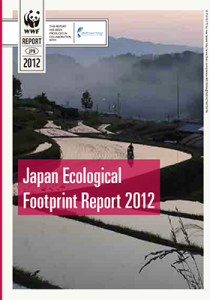 The 2012 Ecological Footprint Report updated Japan’s data to track its progress toward living within the means of our one planet. The report also tracked Footprint trends to historical milestones, and compared the Footprints of Aichi, Okinawa and Tokyo.The report also analyzed the impact of the Fukushima nuclear disaster on biocapacity, estimating it rendered between 2.7 percent and 10 percent of the country’s biocapacity unproductive. Another striking result was that 20 percent of Japan’s Ecological Footprint is associated with food consumption. The report reiterated the need for governments, nonprofits, and consumers to work together to reduce carbon emissions and resource consumption.
The 2012 Ecological Footprint Report updated Japan’s data to track its progress toward living within the means of our one planet. The report also tracked Footprint trends to historical milestones, and compared the Footprints of Aichi, Okinawa and Tokyo.The report also analyzed the impact of the Fukushima nuclear disaster on biocapacity, estimating it rendered between 2.7 percent and 10 percent of the country’s biocapacity unproductive. Another striking result was that 20 percent of Japan’s Ecological Footprint is associated with food consumption. The report reiterated the need for governments, nonprofits, and consumers to work together to reduce carbon emissions and resource consumption.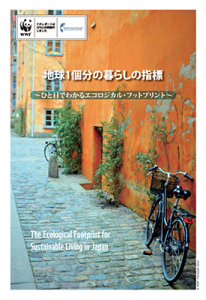 “The Ecological Footprint for Sustainable Living in Japan” (2014) was distributed to the general public to inspire individuals to change behavior, such as reducing food waste, and focus attention on policy change, such as a shift to renewable energy, to reduce the country’s Ecological Footprint.
“The Ecological Footprint for Sustainable Living in Japan” (2014) was distributed to the general public to inspire individuals to change behavior, such as reducing food waste, and focus attention on policy change, such as a shift to renewable energy, to reduce the country’s Ecological Footprint.- In order to raise awareness about the Footprint as a policy-making tool, Global Footprint Network partnered with IDEA Consultants Inc. in 2014 and collaborated on six projects centered on incorporating the Footprint in business, policy-making, and education decisions.
- The Japanese electric company Fujistu created an environmental education tool with WWF Japan and Global Footprint Network’s support. Research Economist Katusnori Iha also (center image below) has taught students about the Ecological Footprint.

- The “How many Earths does your city need” (2019) brochure
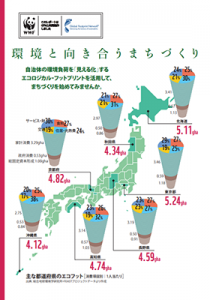 was created for local governments to introduce the Ecological Footprint concept and demonstrate its use in environmental policy and city planning. This brochure builds upon “The Ecological Footprint for Sustainable Living in Japan” from 2015 that focused on the general public.
was created for local governments to introduce the Ecological Footprint concept and demonstrate its use in environmental policy and city planning. This brochure builds upon “The Ecological Footprint for Sustainable Living in Japan” from 2015 that focused on the general public. - As part of the FEAST Project (Lifeworlds of Sustainable Food Consumption and Production-Agrifood Systems in Transition), Global Footprint Network computed the Ecological Footprint for Japan’s 47 prefectures, using a replicable top-down Footprint approach. The analysis included a breakdown of the Ecological Footprint by demographic or other socio-economic indicators. Results indicate:
- The Ecological Footprint varied considerably among the prefectures.
- Total Ecological Footprint and food Footprints increase with urbanization, age, and income.
- Economic decentralization and local food production may be key sustainability strategies.
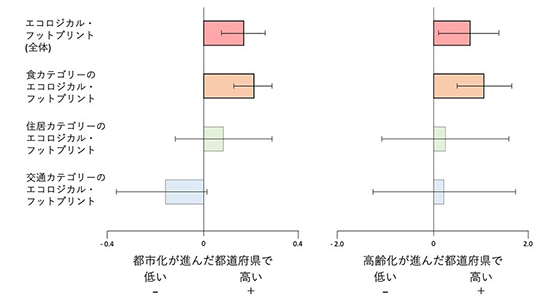
- The FEAST project takes a transdisciplinary approach to explore the reality of, and potential for, sustainable agrifood transition in Asia (Japan, Thailand, Bhutan, and China). Outcomes of the project are detailed in “Decentralization & local food: Japan’s regional Ecological Footprints indicate localized sustainability strategies” published in the Journal of Cleaner Production. Additionally, the project has been covered in Nikkei, Japan’s leading economics newspaper.
Business Footprinting
After the Footprint gained traction with government policy makers, businesses began using the concept to help fully understand their environmental impact.
- In 2012, the Kao Corporation, a large Japanese chemicals and cosmetics company, presented the Ecological Footprint at Japan’s Institute of Life Cycle Development in order for businesses to better understand their total environmental impact.
- The Ecological Footprint also has been used in trade analysis. In collaboration with the Keidanren Conservation Nature Fund and the Association of Southeast Asian Nations (ASEAN), Global Footprint Network analyzed the trade links and dependencies of southeast Asian nations using the National Footprint and Biocapacity Accounts and environmentally extended multi-regional input-output analysis (MRIO) methods. The results were published in the Asian Biotechnology and Development Review.
- Daiichi-Sankyo, a global pharmaceutical company with Japanese origins, applied the Ecological Footprint concept to improve their environmental management. For this multi-year collaboration beginning in 2016, we work with IDEA Consultants Inc. on the business’ Footprint project (trends shown in figure below). Daiichi-Sankyo’s Footprint and reduction targets are detailed on their website.
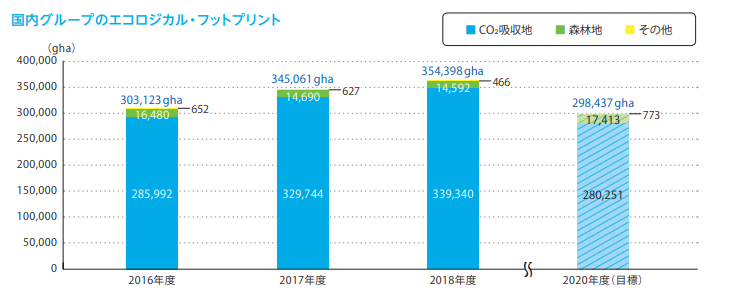
- With the Mitsubishi Research Institute (MRI), Global Footprint Network developed an Ecological Footprint scenario model to envision ways to achieve one planet living. The objective of our engagement in MRI’s 50th Anniversary Project is to support their vision of the future for 2070, fifty years from now. Understanding how humanity can live within the means of one planet is a top priority considering human population may reach 10 billion around 2070. The final report (in Japanese) details the assessments and assumptions made. The figure below shows that Japan can meet one planet living by 2070 if all scenarios can be achieved.
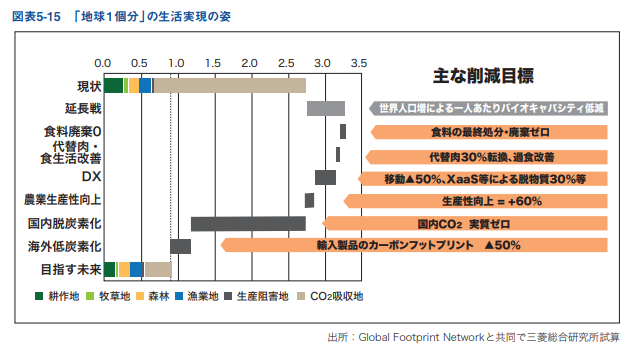
Long-term relationships characterized by mutual respect with our partners have been crucial to the success of Global Footprint Network’s work in Japan. Global Footprint Network looks forward to continued collaboration with these partners in the future and also welcomes inquiries from new potential partners to further amplify our work.
For more information about working with Global Footprint Network in Japan, please contact Katsunori Iha at Katsunori@footprintnetwork.org.
Reports
Kyoto City Basic Environmental Plan Report
Report of Comprehensive Assessment of Biodiversity and Ecosystem Services in Japan (Japanese)
Kyoto City’s Ecological Footprint
Iha, K., Poblete, P., Panda, D., Winkler, S., 2015. A Footprint Analysis of ASEAN: Ensuring Sustainable Development in an Increasingly Resource Constrained World. Asian Biotechnology and Development Review, 17, 57-67.




